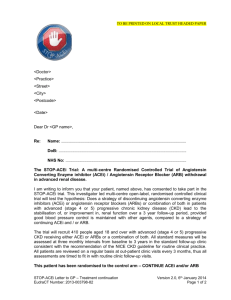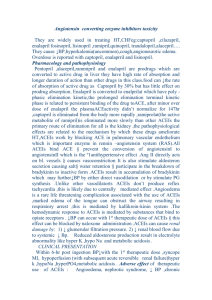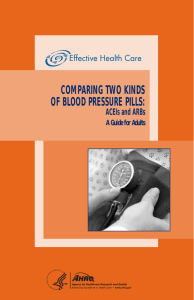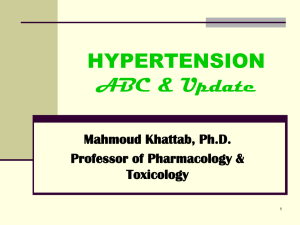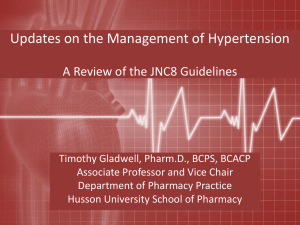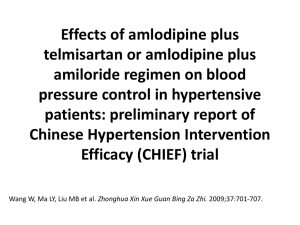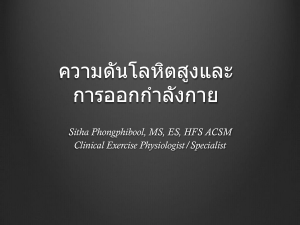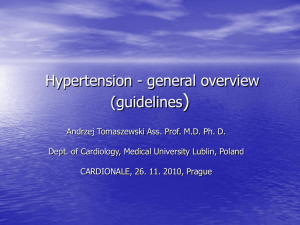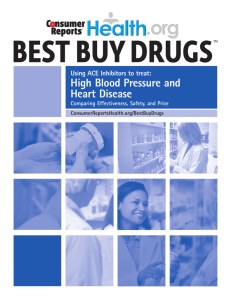ACEIs and ARBs
advertisement
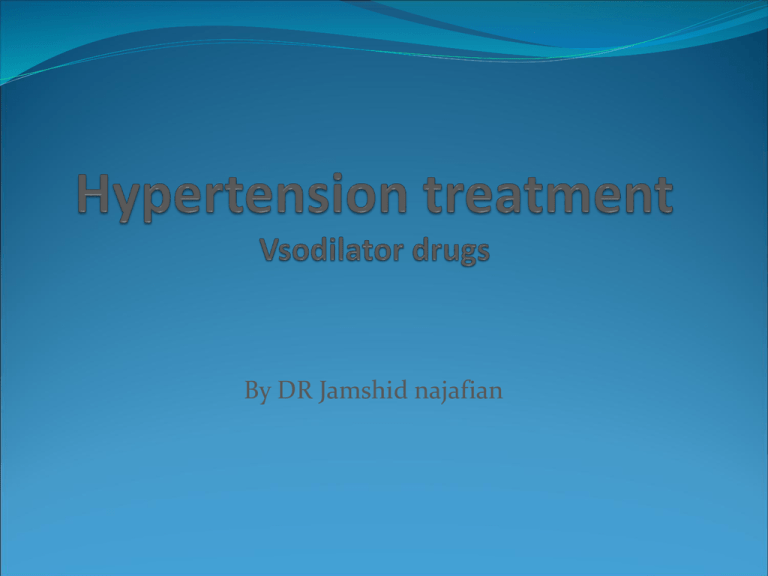
By DR Jamshid najafian Minoxidil and hydralazine Minoxidil and hydralazine 1- Potent hyperpolarizing arterial vasodilators that work by opening vascular ATP-sensitive K+channels Clinical Use 1- Selective and rapid arterial dilation 2-Both drugs induce profound reflex sympathetic activation and tachycardia. Hydralazine 1- Is useful for the treatment of preeclampsia. 2- A combination of hydralazine plus nitrates is useful for the treatment of heart failure ( specifically when hypertensive heart disease causes heart failure most commonly) MinoxidiL 1-Severe hypertension accompanying advanced CKD is the main indication for minoxidil, 2- Must be combined with a beta blocker to prevent excessive reflex tachycardia and with a loop diuretic to prevent excessive fluid retention. Institution of hemodialysis is usually a more effective means of controlling hypertension in this setting. Renin-Angiotensin Inhibitors for Hypertension 1-Angiotensin-Converting Enzyme Inhibitors, 2-Angiotensin Receptor Blockers 3- Direct Renin Inhibitors RAS inhibitors are among the best tolerated of the antihypertensive drugs. ARBs may provide slightly more protection against stroke. The direct renin inhibitor (DRI) aliskiren is one of the newest BP drugs, but there are no completed or ongoing RCTs of aliskiren monotherapy. “Dual RAS blockade” either with an ACEI plus an ARB or with aliskiren plus an ACEI or ARB—is now contraindicated. These combinations must 1-More hypotension, 2-Accelerate the decline in renal function, 3-Cause more hyperkalemia . Mechanisms of Action ACEIs block conversion of the inactive precursor angiotensin I (A I) to A II. ARBs block the action of A II on the type 1 angiotensin receptor. The DRI aliskiren blocks the conversion of prorenin to renin, thereby blocking RAS activation at its origin. High levels of circulating prorenin may stimulate A I receptor–independent signaling pathways, which are both potentially beneficial and potentially harmful. Clinical angioedema associated with ARBs have been reported. ACEIs and ARBs can provoke hyperkalemia in the setting of CKD or diabetes with type 4 renal tubular acidosis. In patients with stage 3 CKD with proteinuria, initiation of ACEI or ARB therapy is often associated with a small transient increase in serum creatinine; therapy can be continued unless the elevation in creatinine is greater than 30%, an indication to decrease the dose or temporarily withhold therapy. ACEIs and ARBs have been used together for extra renal protection in proteinuric patients. Clinical Use ACEIs are easy to use and have a rather flat dose-response curve. In ALLHAT, ACEI monotherapy with lisinopril was equivalent to amlodipine or chlorthalidone monotherapy in all aspects except for producing a smaller reduction in BP and thus less stroke protection in black hypertensive individuals. As monotherapy, ACEIs are generally less effective in lowering BP in black patients and in older patients with low-renin hypertension, when combined with a low-dose diuretic or CCB they are quite effective in these groups . ACEIs have been shown to be equivalent to CCBs in protecting against coronary events Slightly less effective in protecting against stroke, but better in protecting against heart failure. ARBs may confer the same benefits as ACEIs in treating hypertension while avoiding the ACEI-related cough . Losartan is the first ARB to become generic. ACEIs and ARBs have become standard first-line antihypertensive therapy for patients with diabetic and nondiabetic CKD (only for proteinuric CKD) ACEIs and ARBs have comparable effects on renal function. ACEIs and ARBs may prevent or slow progression from glucose intolerance to type 2 diabetes ARBs produce more regression of left ventricular hypertrophy (LVH) than do other antihypertensive drugs. Side Effects All RAS inhibitors are contraindicated in pregnancy (cause fetal renal agenesis and other birth defects. The most common side effect of ACEIs is a dry cough, which is more common in black patients and more common still in Asian patients. If a cough develops in a patient taking an ACEI who needs RAS blockade, an ARB should be substituted. The combination of an ACEI or ARB with aliskiren entails similar risks Moreover, the COOPERATE (Combination Treatment of Angiotensin-II Receptor Blocker and Angiotensin-ConvertingEnzyme Inhibitor in Non-diabetic Renal Disease) trial, which had provided the earlier evidence supporting the practice of dual RAS blockade, was retracted from publication in Lanceton the basis of scientific misconduct. Calcium Channel Blockers 1- They are generally well tolerated 2- Do not require monitoring with blood tests 3- Have proved safe and effective in many large RCTs. 4- Have Antianginal and some anti-arrhythmic effects 5- provide more protection against stroke than other antihypertensive agents do. CCBs (represented by amlodipine) prevent coronary events as effectively as diuretics and RAS blockers do. Mechanism of Action 1-All CCBs block the opening of voltage-gated (L-type) Ca2+ channels in cardiac myocytes and vascular smooth muscle cells. 2-They lower BP by causing peripheral arterial dilation, with the rank order of potency being dihydropyridines >diltiazem >verapami Clinical Use 1-amlodipine was equivalent to chlorthalidone (a potent thiazide-like diuretic) and lisinopril (an ACEI) in protecting against nonfatal coronary events, stroke, and death but provided less protection against heart failure. Advantages of amlodipine 1- Predictable dose-dependent potency 2-Once-daily dosing because of its long half-life 3-Tolerability and cost. 4- Unlike diuretics and RAS inhibitors, a high-salt diet or concurrent nonsteroidal antiinflammatory drug (NSAID) therapy does not compromise the effectiveness of dihydropyridine CCBs. 5- These drugs have some diuretic action (because of dilation of the afferent renal arteriole), 6-Unlike ACEIs, they are equally potent in lowering BP and preventing hypertensive complications in black and nonblack patients. Amlodipine plus an ACEI is one of the most effective drug combinations for preventing CV complications of hypertension. Amlodipine ACEI combination therapy improved CV outcomes better than did beta blocker/thiazide combination than did ACEI/thiazide combination therapy Dihydropyridine CCBs such as amlodipine are less renoprotective than ACEIs or ARBs in patients with proteinuric chronic kidney disease (CKD) Verapamil is weakly antihypertensive and has limited usefulness because of dose-dependent constipation. Diltiazem is intermediate in potency between verapamil and the dihydropyridines and is usually well tolerated Side Effects The principal side effect of the dihydropyridines is dose-dependent ankle edema. This edema appears to be vasogenic because of selective arterial dilation and can respond to concomitant therapy with an ACEI or ARB that causes balanced arterial and venous dilation. Long-acting dihydropyridine CCBs are rarely associated with flushing and headache. All CCBs can cause gingival hyperplasia, a rare side effect that is reversible if detected Verapamil and diltiazem can impair cardiac conduction, especially in older patients also receiving digoxin, beta blockers, or central sympatholytic agents. Alpha-Adrenergic Blockers Mechanism of Action By blocking the interaction of norepinephrine on vascular alphaadrenergic receptors, these drugs cause peripheral vasodilation By increasing blood flow in skeletal muscle, alpha blockers increase insulin sensitivity. By dilating urethral smooth muscle, they improve symptoms of prostatism. Alpha 1 adrenoceptors Prazosin Doxazosin Terazosin Intravenous phentolamine Both alpha1 and alpha2 Phenoxybenzamine Clinical Use and Side Effects Phenoxybenzamine Remains the drug of choice for preoperative management of pheochromocytoma After alpha blockade is achieved, a beta blocker should be added to block an otherwise excessive reflex tachycardia. Selective alpha1-blocking drugs are not first-line agents and should not be used as monotherapy because their propensity to cause Fluid retention can lead to tachyphylaxis Unmask or exacerbate heart failure. are particularly useful in older men with prostatism. Although marketed specifically for prostatism and not as an antihypertensive agent, the selective alpha1A - blocker tamsulosin lowers BP in some men. . Central Sympatholytics Mechanism of Action Stimulation of postsynaptic alpha2-adrenergic receptors and imidazoline receptors in the central nervous system lowers central sympathetic outflow stimulation of presynaptic alpha2 receptors causes feedback inhibition of norepinephrine release from peripheral sympathetic nerve terminals. Clinical Use and Side Effects The central sympatholytics are best reserved for short-term oral treatment of hypertensive urgency. 1-As add-on therapy for very difficult hypertension, central nervous system side effects reduce quality of life. To avoid rebound hypertension between doses, short-acting clonidine must be given every 6 to 8 hours or, whenever possible, discontinued via a gradual tapering schedule. Rebound hypertension is less of a problem with longer-acting preparations (e.g., guanfacine, clonidine patch). Alpha-methyldopa remains useful for the management of hypertension in pregnancy but is no longer a first-line therapy
